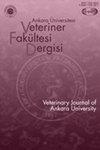THE TREATMENT OF DISTAL FEMORAL FRACTURES OF CATS USING HYBRID EXTERNAL FIXATOR: TEN CASES (2018-2020)
IF 0.9
4区 农林科学
Q3 VETERINARY SCIENCES
引用次数: 0
Abstract
In this research, the clinical and radiological findings after the treatment of distal femoral fractures in cats using hybrid external fixator were evaluated. The research material consisted of totally 10 cats with different ages, races and sexes that were clinically diagnosed with femoral fracture. Hybrid external fixators configured by both circular and linear fixators were used as osteosynthesis materials in the study. Two cases with closed fractures were applied with closed reduction and external fixation methods whereas 8 cases diagnosed with open fracture or excessive dislocation underwent limited open reduction and external fixation. The radiological examination findings revealed that fracture consolidation started on the postoperative 7th and 10th days in 9 and 1 cases, respectively. Bone healing was completed (formation of osseous callus was detected) in 4, 5 and 6 weeks in 2, 2 and 6 cases, respectively. The fixators of all the patients were removed 1 week after completion of healing. In the study, soft tissue complications such as edema of the related extremity, mild pin-base infection and open fracture wound were determined in 3, 3 and 4 cases, respectively. However, these complications were found not to negatively affect the healing time of the fractures. As a consequence, it was concluded according to the data obtained from this study that distal femoral fractures in the cats within the age and weight range of the study can be successfully treated using hybrid external fixator method混合外固定架治疗猫股骨远端骨折10例(2018-2020)
在本研究中,对使用混合外固定架治疗猫股骨远端骨折后的临床和影像学表现进行了评估。研究材料包括临床诊断为股骨骨折的10只不同年龄、种族和性别的猫。采用由圆形和线性固定架组合而成的混合外固定架作为骨合成材料。2例闭合性骨折行闭合性复位外固定,8例诊断为开放性骨折或过度脱位行有限切开复位外固定。影像学检查结果显示,9例和1例分别于术后第7天和第10天开始骨折巩固。2例、2例、6例于4周、5周、6周完成骨愈合(发现骨痂形成)。所有患者在愈合完成后1周取出固定物。在本研究中,分别有3例、3例和4例软组织并发症,如相关肢体水肿、轻度针基感染和开放性骨折创面。然而,这些并发症并未对骨折愈合时间产生负面影响。因此,根据本研究获得的数据可以得出结论,在研究年龄和体重范围内的猫,使用混合外固定架方法可以成功治疗股骨远端骨折
本文章由计算机程序翻译,如有差异,请以英文原文为准。
求助全文
约1分钟内获得全文
求助全文
来源期刊
CiteScore
1.50
自引率
0.00%
发文量
44
审稿时长
6-12 weeks
期刊介绍:
Ankara Üniversitesi Veteriner Fakültesi Dergisi is one of the journals’ of Ankara University, which is the first well-established university in the Republic of Turkey. Research articles, short communications, case reports, letter to editor and invited review articles are published on all aspects of veterinary medicine and animal science. The journal is published on a quarterly since 1954 and indexing in Science Citation Index-Expanded (SCI-Exp) since April 2007.

 求助内容:
求助内容: 应助结果提醒方式:
应助结果提醒方式:


